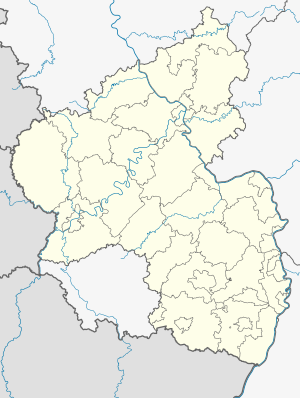Deesen tunnel
| Deesen tunnel | ||
|---|---|---|
|
Driver's cab perspective of an ICE approaching the tunnel towards Cologne. Deesen can be seen on the left , the motorway on the right. The south-west portal of the tunnel can be seen in the background at a distance of about one kilometer.
|
||
| traffic connection | High-speed route Cologne – Rhine / Main | |
| place | Deesen | |
| length | 338 m | |
| Number of tubes | 1 | |
| construction | ||
| Client | Deutsche Bahn | |
| business | ||
| release | 2002 (commercial commissioning) | |
| location | ||
|
|
||
| Coordinates | ||
| Northwest portal | 50 ° 30 ′ 55 " N , 7 ° 41 ′ 52" E | |
| Southeast portal | 50 ° 30 ′ 45 " N , 7 ° 42 ′ 10" E | |
The Deesen tunnel is a 338 m long railway tunnel on the high-speed Cologne – Rhine / Main line . It runs in the area of the Rhineland-Palatinate local community Deesen and therefore bears his name.
It takes up two tracks on a slab track , which can be driven on as planned at 300 km / h.
course
The north-west portal is at kilometer 76.4, the south-east portal at kilometer 76.8.
The structure runs parallel to the Federal Motorway 3 in the south, bundling traffic routes . The tunnel route runs in a straight line to the southeast. The gradient drops in this direction.
After an above-ground section of the route, the Oberhaider-Wald-Tunnel follows to the southeast . To the northeast, after around 20 km, the next tunnel is the Fernthaltunnel .
history
planning
According to the planning status from the end of 1995, the tunnel was not yet planned.
The building is the result of "optimized planning". The original plan was to compensate for the difference in height between the new line and Autobahn 3 with a trough structure north of the L 306 state road . This, as well as a 115 m long, planned retaining wall between Bergstrasse and Sayntalstrasse (Landstrasse L304) could be omitted.
At the end of 1997, the structure was planned to be 338 m long. This corresponds to the length realized later.
construction
In the planning and construction phase, the tunnel was part of the middle section in Lot B of the new line and was built by the ARGE KDD ( Arbeitsgemeinschaft Kutscheid, Dernbach / Deesen ) consisting of six companies .
The entire length of the tunnel was built using the cut-and-cover method.
In mid-1999 it was two thirds completed.
In February 2000, along with the Hellenberg tunnel, it was the only completed tunnel in the high-speed section of the new line.
Individual evidence
- ↑ a b DBProjekt GmbH Cologne – Rhein / Main: New Cologne-Rhein / Main line: route map , Frankfurt, June 1999.
- ^ Deutsche Bahn AG, network division, project management for the Cologne – Rhein / Main line (publisher): route map for the new Cologne-Rhein / Main line . Map from November 1995, Frankfurt 1995.
- ↑ a b DBProjekt GmbH Cologne – Rhein / Main, project management (ed.): New Cologne – Rhein / Main line: construction section middle section B: Selters – Brechen , brochure (20 pages), Frankfurt am Main, January 1999, p. 5.
- ↑ DBProjekt GmbH Cologne – Rhein / Main (Ed.): Route map: New Cologne-Rhein / Main line , Frankfurt am Main, November 1997.
- ↑ Arguments and views . In: On the subject , ZDB -ID 2115698-0 , edition 3/2001, June 2001, p. 12.
- ↑ Ludwig Martin: A few meters below the Dernbach triangle . In: DB ProjektBau GmbH, Frankfurt (ed.): New Cologne – Rhine / Main line. Bridges and tunnels . without ISBN. Pp. 71-75.
- ↑ According to plan on the longest construction site in Germany . In: DBProjekt Köln-Rhein / Main (Ed.): On the topic , ZDB -ID 2115698-0 , Issue 4/1999, Frankfurt am Main, August 1999, pp. 4-7.
- ^ Status of tunnel work on the new Cologne – Rhine / Main line . In: DBProjekt Köln-Rhein / Main (Ed.): On the topic , ZDB -ID 2115698-0 , issue 1/2000, Frankfurt am Main, February 2000, p. 2.

